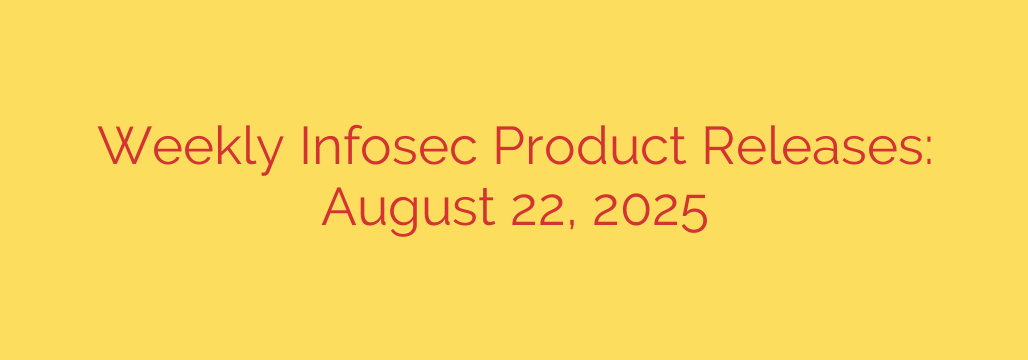
The Cutting Edge of Cyber Defense: New Security Tools for a Complex Threat Landscape
In the relentless battle against cyber threats, innovation isn’t just an advantage—it’s a necessity. As attackers refine their techniques, security vendors are racing to develop more intelligent, integrated, and proactive solutions to defend critical assets. This week, we’ve seen the launch of several groundbreaking products designed to address some of the most pressing challenges in cybersecurity, from AI-driven threat hunting to comprehensive cloud protection.
Here’s a look at the latest advancements that security professionals should have on their radar.
QuantumShield AI: Predictive Threat Detection Enters a New Era
One of the most exciting new releases is QuantumShield AI, a platform that moves beyond traditional reactive security. Instead of waiting for a malicious file to execute or a known signature to appear, this solution uses predictive artificial intelligence to identify and neutralize threats before they can cause harm.
By analyzing code behavior, network traffic patterns, and system calls in real-time, the platform can spot the subtle indicators of a zero-day exploit or a novel ransomware strain. Its core strength lies in its ability to understand intent, distinguishing between legitimate administrative actions and malicious activities masquerading as normal behavior.
Key features include:
- Proactive threat neutralization that stops attacks at the earliest pre-execution stage.
- Deep learning models trained on vast datasets to continuously improve anomaly detection.
- A significant reduction in false positives, freeing up security teams to focus on genuine threats.
For organizations struggling with alert fatigue and sophisticated, fileless attacks, this AI-driven approach represents a major step forward in endpoint and server security.
StratusGuard CNAPP: Unifying Cloud Security Management
The complexity of multi-cloud environments has created significant security gaps, with misconfigurations and unprotected workloads serving as a primary entry point for attackers. StratusGuard’s new Cloud-Native Application Protection Platform (CNAPP) aims to solve this by providing a single, unified solution for cloud security.
This platform integrates what used to be separate tools: Cloud Security Posture Management (CSPM) and Cloud Workload Protection (CWPP). This means security teams get a complete picture, from high-level infrastructure configuration in AWS, Azure, and GCP down to the runtime security of individual containers and serverless functions.
Highlights of the platform:
- Unified visibility and policy enforcement across all major cloud providers.
- Automated remediation of misconfigurations, fixing vulnerabilities before they can be exploited.
- Agentless and agent-based options for deep workload protection without compromising performance.
By breaking down the silos between infrastructure and application security, this CNAPP solution helps businesses embrace the cloud with greater confidence and control.
Veritas Data Sentinel: Context-Aware Data Loss Prevention (DLP)
Standard Data Loss Prevention (DLP) tools often struggle with the modern, collaborative workplace, either blocking legitimate work or failing to stop sophisticated data exfiltration. Veritas Data Sentinel is a next-generation DLP solution built on a foundation of context-aware security.
Instead of relying on rigid, keyword-based rules, this tool understands the who, what, where, and why of data access. It assesses user roles, the sensitivity of the data, the application being used, and the destination to make more intelligent policy decisions. For example, it can differentiate between a project manager sharing a sensitive document with a verified partner via a secure portal and an unauthorized user trying to upload the same file to a personal cloud storage account.
Security teams can benefit from:
- Highly accurate policy enforcement that minimizes disruption to business workflows.
- Robust protection for structured and unstructured data, whether it’s at rest, in use, or in motion.
- Simplified compliance reporting for regulations like GDPR, CCPA, and HIPAA.
Actionable Security Advice: How to Evaluate New Tools
While these new products are promising, integrating any new solution requires careful consideration. Here are a few essential tips for evaluating new security tools for your organization:
- Identify Your Specific Gaps: Before shopping for a solution, conduct a thorough risk assessment. Understand exactly what problem you are trying to solve. A cutting-edge AI tool is useless if your primary vulnerability is a lack of basic patch management.
- Prioritize Integration: A powerful tool that doesn’t integrate with your existing security stack (like your SIEM, SOAR, or firewall) will only create more work. Look for robust API support and proven integrations to ensure it enhances, rather than complicates, your security ecosystem.
- Run a Meaningful Proof of Concept (PoC): Never buy a security product based on a demo alone. Insist on a PoC in your own environment with your own data and team. This is the only way to validate a vendor’s claims and see how the tool performs under real-world conditions.
- Consider the Total Cost of Ownership (TCO): The initial purchase price is just one part of the cost. Factor in implementation, training, maintenance, and the personnel required to manage the tool effectively. A cheaper tool that requires a full-time analyst may be more expensive in the long run.
Staying informed about these advancements is a core component of a resilient cybersecurity strategy. By understanding the capabilities of the latest tools, organizations can better prepare to defend against the threats of tomorrow.
Source: https://www.helpnetsecurity.com/2025/08/22/new-infosec-products-of-the-week-august-22-2025/








